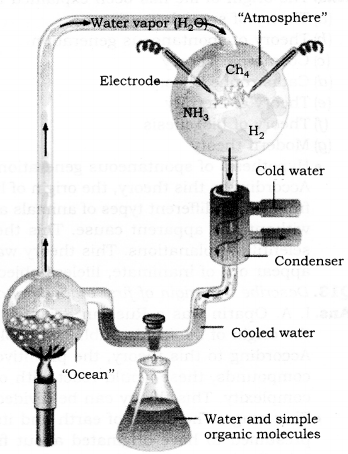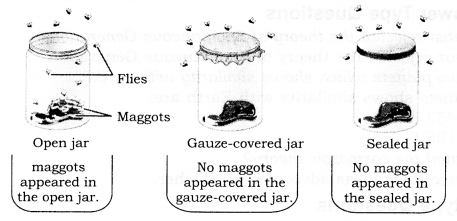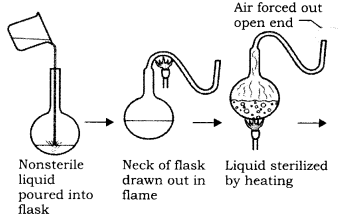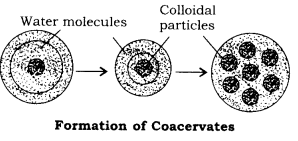RBSE Solutions for Class 9 Science Chapter 5 Concept of Life are part of RBSE Solutions for Class 9 Science. Here we have given Rajasthan Board RBSE Class 9 Science Chapter 5 Concept of Life.
| Board | RBSE |
| Textbook | SIERT, Rajasthan |
| Class | Class 9 |
| Subject | Science |
| Chapter | Chapter 5 |
| Chapter Name | Concept of Life |
| Number of Questions Solved | 51 |
| Category | RBSE Solutions |
Rajasthan Board RBSE Class 9 Science Chapter 5 Concept of Life
Concept of Life Textbook Questions Solved
Objective Type Questions
Question 1.
In-Universe, life is possible on which planet after earth?
(A) Mercury
(B) Jupiter
(C) Venus
(D) Mars
Answer: D
Question 2.
Which character among the following is not found in non-living things:
(A) Reproduction
(B) Development
(C) Growth
(D) All the above
Answer: D
Question 3.
Due to Oparin’s hypothesis, the origin of life is divided into how many stages?
(A) 5
(B) 6
(C) 7
(D) 8
Answer: C
Question 4.
Who gave the theory of Biogenesis?
(A) Oparin
(B) Francescoredi
(C) Van Helmont
(D) Leabig
Answer: B
Question 5.
The name of a planet similar to earth discovered on 17th April 2014 is:
(A) Kepler – 186 f
(B) Kepler – 452 a
(C) Kepler – 186 g
(D) Kepler – 452b
Answer: A
Concept of Life Very Short Answer Type Questions
Question 6.
Which scientist rejected the theory of Spontaneous Generation?
Answer
Louis Pasteur rejected the theory of Spontaneous Generation.
Question 7.
Name the two planets which show similarity with earth?
Answer
The two planets show similarity with Earth is:
- Kepler – 452 b
- Kepler – 186 f
Question 8.
Who advocated the cosmozoic theory?
Answer
The cosmozoic theory was advocated by Ritcher.
Concept of Life Short Answer Type Questions
Question 9.
Explain the difference between living and non-living with an example?
Answer
Living things need food, air and water they respire, they grow and show movement while non-living things do not show any of these characteristics.
Question 10.
Explain the experiment of Miller with a diagram.
Answer

In support and favour of Oparin’s theory, Stanley Miller performed an experiment, as described with an example. Stanley Miller set up an apparatus as shown below. He filled the chamber of the apparatus with methane (CH4), ammonia (NH3), Hydrogen (H2) and Water (H2O). In this mixture, he passed electric discharge of 60,000 volts for a week. In one side boiled water, and in another side, mixture with condensed water was, circulated. During this process, a red coloured liquid was obtained.
On analysis, it was found that the liquid contained several amino acids, glycerine, alanin and other organic compounds.
Thus, complex organic substances evolved from simple gases.
Question 11.
Describe the theory of Biogenesis?
Answer
Biogenesis means that life originates only from pre-existing life. Francesco Redi criticised the spontaneous generation hypothesis, by conducting his experiment. He demonstrated that abiogenesis cannot exist. He took few fishes in a flask and cooked them nicely, so nothing could have remained alive. He kept the meat in three jars, one was left uncovered, second was covered with parchment and third with a fine muslin cloth. In a few days, maggots appeared in the first jar only. Plenty of flies were seen sitting and laying their eggs on the third jar but the maggots appeared in the meat showing that flies arise from the eggs, laid down by the parent flies and that maggots cannot appear spontaneously. Pasteur also emphasised that even the simplest of micro-organisms are not capable of spontaneous generation because they also develop from the pre-existing micro-organisms by reproduction.

Concept of Life Long Answer Type Questions
Question 12.
Name the various theories related to the origin of life? Explain any one of them? Ans. The origin of life has been explained through various theories as follows:
(a) Theory of special creation
(b) Theory of spontaneous generation (Abiogenesis)
(c) Cosmozoic Theory (Theory of catalysm or catastrophism)
(d) Catastrophe Theory (Mechanist theory)
(e) Theory of eternity
(f) Theory of biogenesis (Mechanist theory)
(g) Modern theory (The chemical origin of life)
A hypothesis of spontaneous generation of life on earth:
According to this theory, the origin of life was from lifeless or non-living substances, from which different types of animals and plants appear suddenly or spontaneously, without any apparent cause. This theory was quiet acceptable in the absence of scientific explanations. This theory was rejected, by the fact that the organism does not appear out of inanimate, lifeless objects.
Question 13.
Describe the origin of the first organism according to the hypothesis of Oparin?
Answer
I. A. Oparin was a Russian Scientist of biochemistry, who suggested a theory of the origin of life in his published book ‘Origin of life’, in 1963. According to this theory, the primitive oceans contained a large quantity of organic compounds, these would react with one another to form structures of increasing complexity. This theory can be divided into five stages.
1. First stage: The origin of the earth and its primitive atmosphere- The earth has been presumed to have originated about five billion years ago. It was as hot as the Sun. Initially, there existed a hot rapidly rotating ball of gases, made up of free molecules of carbon, hydrogen, oxygen and nitrogen, along with other free molecules of elements. Gradual cooling led to the formation of the water molecule, which provided a suitable medium for chemical reactions, due to which several compounds such as methane (CH4), ammonia (NH3) and water were formed. They were dissolved in water, that was collected in the form of oceans, lakes, rivers etc. According to oparin, it is in this water that life originated first.
2. Second Stage: Synthesis of simple compounds- The formation of water, ammonia and methane- the large bodies of water having minerals and salts was the key event in the origin of life. Methane being reactive, having fused with other compounds to form simple organic compounds such as Ethane, Butane, Propane, Ethyl Alcohol (C2H5OH), Methyl alcohol (CH3OH), Glycerol, Fats, Sugars, etc. The dissolved ammonia forms the nitrogenous organics like amino acids, purines, pyramidines and finally, nucleic acid. Hence, in this phase all the chemical compounds are formed in the oceanic water, required for the origin of life.
3. Third Stage: Formation of macro-molecules or complex organic molecules- Pyramidine and purines, combined with phosphorus and sugars of oceanic water and formed nucleotides ultimately from DNA and RNA. This sort of chemical reactions went on. Nucleic acids, proteins and fats on synthesis form nucleoproteins. In short, in this step, the formation of nucleoproteins takes place by polymerisation of nucleotides. These molecules were like naked genes. Their formation indicates the step for differentiating between life and no-life. Hundreds and thousands of these nucleotides were linked together in different combinations, producing the complete nucleic acids.
4. Fourth Stage: Formation of Nucleoproteins- Due to the aggregation tendency of molecules, giant molecules of nucleoproteins were formed, by the union of nucleic acid and protein molecules. It is presumed that such giant nucleoproteins had certain characteristics of a free-living gene. A number of such genes might have aggregated to form a single large unit.
Thus, by aggregation tendency of molecules, large or macromolecules of nucleoproteins are formed, around which a coat of the macromolecules of carbohydrates(like cellulose), fats and minerals were formed, in the form of a membranous structure. The central core around which these membranes developed is referred to as organic soup, which has free entry and consists of molecules. In this way, the membrane-bound ‘soup’ acquired the properties of incorporating the absorbed molecules and to split a part of a portion of itself. This represents the primitive cell, which is still without a distinct and definite nucleus. Such cells are still found, in certain algal forms. This could be compared with the present day, virus and was named as proto-virus. This shows that the nucleus developed later than the cell. Thus, the virus is regarded as a connecting link between the living and non-living forms.
5. Fifth Stage: Formation of the primary organism called coacervates- The big organic macro-molecules has a tendency to aggregate in various combinations to form huge, colloidal particles called “Coacervates”. These coacervates with nucleoprotein molecules surrounded by nutrient shells and limiting membrane were supposed to be the first living cell. Natural selection must be operated at this level, and the coacervates with more favourable internal arrangements became more abundant. Those with nutritive shells proved to be more successful and became abundant and finally, led to the development of cells.
Concept of Life Additional Questions Solved
Multiple Choice Questions (MCQs)
Question 1.
First of all, which of the following was considered, responsible for the origin of life on earth-
(A) Cosmic panspermic
(B) God
(C) Coincidental origin
(D) Spontaneous origin
Answer: B
Question 2.
What is the basis of life according to the present view-
(A) Grace of God
(B) Effect of sunlight on mud
(C) Spontaneous generation
(D) None of the above
Answer: D
Question 3.
Which one of the following elements were not present in the free state in the atmosphere at the time of origin of life-
(A) Hydrogen
(B) Oxygen
(C) Nitrogen
(D) Ammonia
Answer: B
Question 4.
Louis Pasteur was successful in proving the spontaneous generation, wrong because-
(A) he was fortunate
(B) the yeast used by him was dead
(C) his laboratory was clean
(D) he used flamingo necked flask
Answer: D
Question 5.
Oparin’s hypothesis was experimentally proved by-
(A) Miller’s experiment
(B) Redi’s experiment
(C) Pasteur’s experiment
(D) All the above
Answer: A
Question 6.
The British Scientist who got Bhartiya Citizenship was-
(A) J.B.S Haldane
(B) A.I.Oparin
(C) S.Miller
(D) Louis Pasteur
Answer: A
Question 7.
The time of origin of life was that when there was no other organism, who expressed this idea:
(A) Aristotle
(B) Miller
(C) Pasteur
(D) Shull
Answer: D
Question 8.
According to Naturalistic theory; Protein, Carbohydrate and lipids were formed, so it is also called as –
(A) Spontaneous generation
(B) Creation
(C) Chemical evolution
(D) All the above
Answer: C
Question 9.
Which among the following gases was absent on Primitive earth?
(A) CO2
(B) CH4
(C) NH3
(D) O2
Answer: D
Question 10.
Who said that organisms develop from pre-existing organisms-
(A) Aristotle
(B) Louis Pasteur
(C) Oparin
(D) Morgan
Answer: B
Question 11.
Coacervates are clusters of-
(A) Proteins
(B) Sugars
(C) Fats
(D) Sugars and fats
Answer: A
Question 12.
Life cannot originate from inorganic materials now, because of
(A) Low atmospheric temperature
(B) High degree of Pollution
(C) High atmospheric oxygen
(D) The absence of raw materials
Answer: B
Question 13.
Who did an experiment to prove that “organic compounds were the basis of life”.
(A) Darwin
(B) Stanley Miller and Horald Urey
(C) Melvin
(D) Fox
Answer: B
Question 14.
Which one of the following is not related to the origin of life-
(A) Wallace
(B) Urey
(C) Haldane
(D) Aristotle
Answer: A
Question 15.
The original atmosphere of earth had water, methane, and ammonia. This view was given by-
(A) Saint Thomas
(B) Darwin
(C) Oparin and Haldane
(D) Pirie
Answer: C
Concept of Life Very Short Answer Type Questions
Question 1
Which scientist suggested that amino acids were very important for the origin of life?
Answer
Oparin.
Question 2.
Which scientist tested the biochemical hypothesis of the origin of life?
Answer
Miller.
Question 3.
What were the views of Louis Pasteur?
Answer
According to Louis Pasteur, life originated only from pre-existing life.
Question 4.
Name the first chemical elements which contributed to the chemical origin life?
Answer
Carbon, Hydrogen and Nitrogen.
Question 5.
What were the ingredients used by Stanley Miller in his experiment?
Answer
CH4, NH3, H2O, H2.
Question 6.
What is the variation of the temperature of the earth?
Answer
The temperature variation on earth is between-15°C to 50°C with certain areas exceeding these two limits.
Question 7.
Who contradicted the theory of special creation?
Answer
Louis Pasteur.
Question 8.
Name the scientists, who created life in the laboratory
Answer
Stanley Miller, Calvin and S.W. Fox.
Question 9.
What were the end products of the experiment of Miller?
Answer
Amino acids.
Question 10.
What is Cosmic theory?
Answer
According to Cosmic theory, spores of life come from a distant planet.
Concept of Life Short Answer Type Questions
Question 1.
Why is earth considered the most ideal, for the origin of life?
Answer
It is neither too far, nor too near from Sun, whereby the temperature on this planet was most ideal for the origin of life.
For example: Venus is near the Sun, therefore it has a temperature of boiling water. While Mars being away, is a frozen planet.
Question 2.
What was the view of Aristotle regarding the origin of life?
Answer
Aristotle’s view is that animals like frogs, toads and snakes appeared spontaneously out of mud, while rotting dung and mud gave rise to insect larvae, worms insects like glow worms, wasps and bees. Flies, moths, bugs, lice and beetles suddenly appeared out of farm manure, decaying wood, vinegar and fruit out of the higher animals, fishes and eels were believed to appear out of the mud of the lakes and decaying water plants.
Question 3.
Which principle of origin of life is proved by the experiment of Louis Pasteur?
Answer
Louis Pasteur in his experiment boiled an organic fluid (called Bouillon) in a special type of flask with a long S-Shaped tube, whose neck was sealed. The nutritive material remained sterile in the flask so that no micro-organism could enter into the flask. When he opened the flask, the micro-organisms from the air immediately entered into the flask and started reproducing in the broth. The S-shaped tube did not permit the entry of the micro-organisms into the flask, immediately.

When the S-shaped tube was broken off, near the neck of the flask, microbes at once, entered the flask and propagated in the broth. Pasteur reasoned that micro-organisms had entered the flask from the atmosphere. But in the first case, when the long S-shaped tube was intact, they failed to reach the broth, as they got trapped on the walls of the tube. By boiling the broth, he had made the medium sterile (free of micro-organisms) and micro-organisms from the atmosphere were prevented from entering the flask by the S-shaped tube. With this experiment, he proved that selfgeneration of an organism is impossible.
Question 4.
What is Cosmic Panspermia hypothesis?
Answer
Cosmic Panspermia hypothesis: According to Richter Adrenius and Prayer, spores of life came to earth from some distant planet, along with metiorites which keep on reaching the earth from time to time. According to this theory, a microscopic form of life accidentally reached the earth, with small bits of metiorites. This theory has been rejected, because the intense cold, extreme dryness and intense radiations of interplanetary space would not have allowed the spores of life to reach the earth, without damage. This theory only shifts the origin of life from earth, to some other planet, from where the spores of life fell on the earth.
Question 5.
Which main gases were present in the early atmosphere of the earth?
Answer
The various gases present in the immediate atmosphere (troposphere) of the earth are oxygen, about 21% nitrogen about 78%, carbon dioxide about 0.03% and water vapours in variable amounts. In addition, there are traces of inert gases, like ozone, argon, xenon, neon, krypton and helium. Each of these gases serves as basic components of the living organisms.
For example, Carbon dioxide is the main component of the atmosphere, which is needed in the process of photosynthesis, while ozone protects the living organisms from the ultraviolet radiations.
Question 6.
State, from what type of substances j the first organism originated on earth, according to the hypothesis of Oparin?
Answer
According to Oparin the first living organism on earth is formed by the large colloidal aggregates. These colloidal bodies formed cell-like structures, are called coacervates. They selectively absorb proteins and other materials which increases its internal complexity and led to its growth. The first living cell “protocell”, is originated in the ocean.
Question 7.
What type of substance was formed by the dissolution of organic substances in the early oceans?
Answer
The formation of water, NH3, CH4, minerals and salts was the key event in the origin of life. CH4 being reactive, fused with other compounds to form simple organic compounds, such as ethane, propane, glycerols, fats, sugars, etc.
The dissolved ammonia forms the j nitrogenous organics like amino acids, purines, pyramidine and nucleic acid. Hence, the chemical compounds are formed in the oceanic water, required for the origin of life.
Question 8.
What are coacervates?
Answer
The organic macromolecules had a tendency to aggregate in various combinations, to form large colloidal particles called coacervates- They have long been known to occur, when dispersed colloidal particles separate spontaneously out of solution into droplets, because of special conditions of acidity, temperature etc. If there is more than one type of macromolecular particle in the colloid, complex coacervates can form.

Question 9.
What was the structure of a first formed cell?
Answer
The first cell got organised into self-replicating, independent membrane-bound clusters of nucleoproteins, through a number of possible ways. According to the theory, it was the clumping or aggregation of nucleoproteins with a covering of suitable semipermeable membrane or a shell of nutrients, after which more complexity was achieved.
Question 10.
What was the experimental model of S.W? Fox?
Answer
Fox took the same molecules which Miller took, but subjected them to a much lower temperature from 180°C to 150°C. With the decrease in temperature, he could get as many as 18 of the total of 20 amino acids and some nucleotides.
Question 11.
Write the names of eight steps of origin of life.
Answer
Eight steps of production of life are as follows-
- Atomic stage 2. Molecular stage
- Formation of organic compounds
- Formation of colloids and coacervates
- Formation of genes and virus
- Production of prokaryotic cells
- Production of autotrophs
- Production of cells with a nucleus.
Question 12.
What was the role of Sun in the origin of life?
Answer
Sun provided the energy, released in the form of ultraviolet radiations. Sunlight helped in photosynthesis. It also helped in the combination of C, H and N, while the later changes with the help of sunlight in the form of large molecules, such as nucleic acids, proteins and lipids.
Class 9 Science Concept of Life Rajasthan Board Long Answer Type Questions
Question 1.
Explain the differences between the living and non-living?
Answer
Differences between the Living and the Non-living are
| Subject | Living | Non-Living |
| – Form and Size | – Living objects possess a definite form and size. | – Non-living objects have no form and size of their own. They can be moulded into different shapes. |
| – Life Span | – Different living organisms have different life spans, after which they die. | – Non-living objects remain as such for centuries. |
| – Organisation | – Body made up of cells. It can be distinguished into different organs. | – Cells do not present and hence, no organs are there. |
| – Metabolism | – Perform metabolism, i.e. nutrition, respiration and excretion. | – No constructive and destructive changes are performed by non-living. |
| – Nutrition and growth – Respiration |
– Require nourishment for maintenance and growth. | – Nourishment not needed, Growth, if any, is external. |
| – Respiration | – Complex food materials are oxidised in the cells at ordinary temperatures and energy is liberated, for the life processes, to be carried on. | – Non- living objects do not respire. Combustible substances, however, burn at higher temperatures and release energy. |
| – The release of Energy- | – ATP is found in all living cells and it is this compound which releases energy in a controlled and usable form | – ATP is absent and there are no cells. |
| – Excretion | – Excretory substances are formed within the body and are eliminated from time to time. | – No nourishment and hence, no excretion. |
| – Movement and Locomotion | – Show movements on their own accord. It may be movement of the entire organism or some of the organs. | – Do not show movement on their own accord. They may be made to move, by some external forces. |
| – Irritability | – Living organisms respond to an external stimulus. | – Irritability is absent. |
| – Reproduction | – For the continuation of the species, all living organisms reproduce sexually, or vegetatively. DNA and RNA are a universal occurrence in living organisms. | – They do not reproduce to form similar organisms. DNA and RNA are not present. |
We hope the given RBSE Solutions for Class 9 Science Chapter 5 Concept of Life will help you. If you have any query regarding Rajasthan Board RBSE Class 9 Science Chapter 5 Concept of Life, drop a comment below and we will get back to you at the earliest.